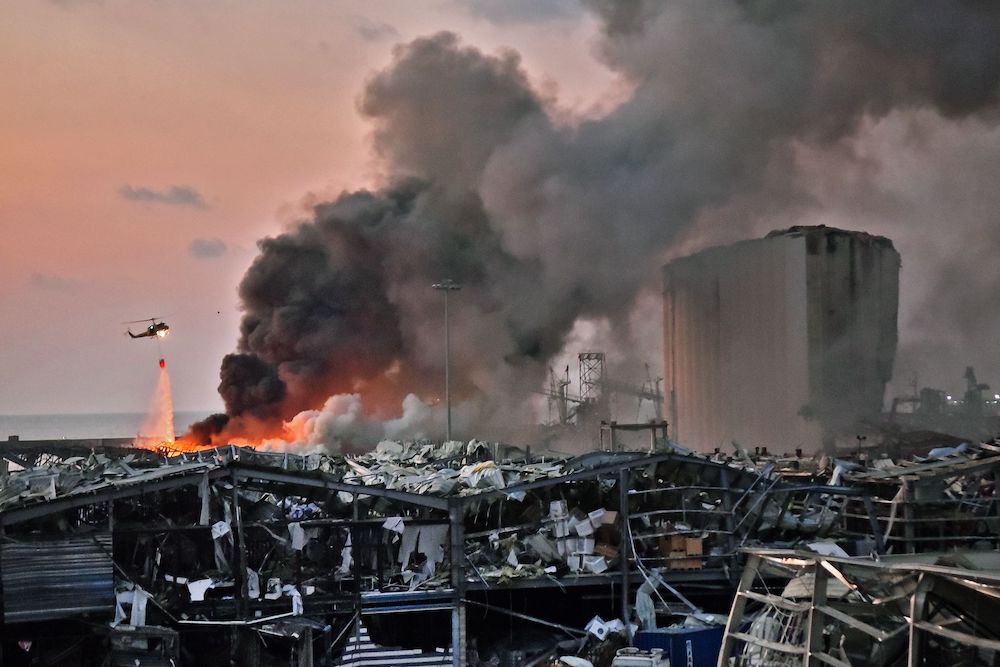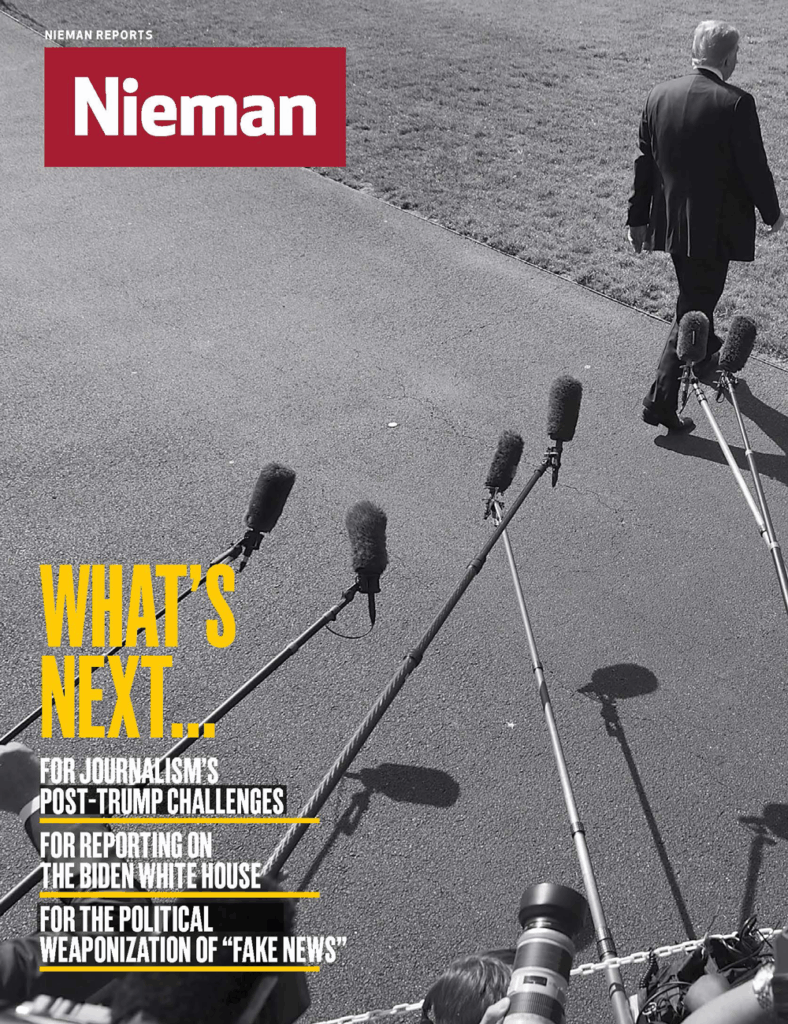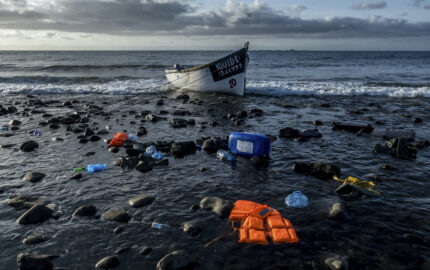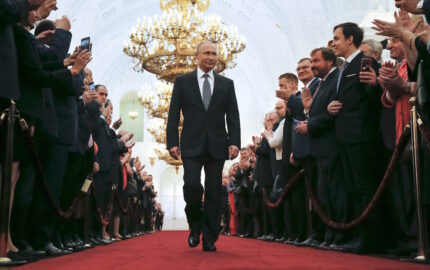Seven years before the largest explosion since Hiroshima obliterated a large part of the port of Beirut in August, claimed some 200 lives, and left some 300,000 homeless, port authorities who could have prevented the blast assaulted and detained investigative TV journalist Riad Kobaissi and his crew.
In 2013, Kobaissi had taken a bullhorn to the streets, calling out then head of Lebanese Customs, Chafic Merhi, who oversaw the entry of goods into the port, for refusing to be interviewed about allegations of smuggling and corruption. Minutes later, security agents tackled the cameraman, ripped the bullhorn from Kobaissi’s hands, and kicked, punched, and dragged both men. The incident was broadcast live on air until Kobaissi and his crew disappeared into the Customs Office and were transferred to a high court.
Kobaissi’s defiance personified a boldness that has become increasingly common in Lebanese media
Kobaissi works for Al Jadeed (“New TV”), one of the most popular channels in Lebanon, a pioneer in investigative reporting in the country. It’s not uncommon for angry and armed supporters of the nation’s opposing ruling parties to gather outside the station’s headquarters to protest its critical coverage.
On that day in 2013, Al Jadeed replayed the assaults on a loop, and a crowd of a few hundred supporters gathered outside the court to protest, chanting “freedom” for several hours until the crew was released. When Kobaissi finally emerged, his face bruised, he proclaimed that he would continue to expose port chief Merhi’s dealings. (Merhi was arrested in August in connection with the detonation of 2,750 metric tons of ammonium nitrate improperly stored in the port of Beirut.)
Kobaissi’s defiance personified a boldness that has become increasingly common in Lebanese media, both on mainstream channels and at several new online media outlets that have flourished despite a state-backed crackdown on public expression.
With dozens of privately-owned news outlets, Lebanon’s vibrant mediascape has long been seen as the freest in the Arab world, a region dominated by sycophantic, state-owned media. But this reputation has come under fire in recent years as several prominent journalists and activists faced defamation lawsuits and police interrogations. Meanwhile, hundreds of protesters have been detained during demonstrations that swept the country during an unprecedented street uprising that began last October. Several journalists covering the protests have also been attacked by security forces.
Even before the political turmoil began, some of the country’s oldest and largest newspapers and broadcasters had either closed or scaled back in light of Lebanon’s economic collapse, crippling an already tiny advertising market, worsened by Venezuela-style hyperinflation. But at the same time, a number of new media collectives and platforms have emerged and mainstream media, always dominated by political party-owned or -affiliated publications and broadcasters, have changed their focus. Lebanon’s most popular TV stations have provided wall-to-wall coverage of the demonstrations, at times serving as an open mic platform for public grievances and protesters’ attacks on the government. New nightly programs have emerged to investigate corruption and mismanagement, and there is an increasingly audacious attitude among many TV personalities. In August, a week after the port explosion, Wassim Oraby, a news anchor for the state-owned broadcaster Tele Liban, quit on air, voicing his disgust with the country’s politicians who had transformed it into “a graveyard of dreams.”
In politics and media, there are new norms of demanding accountability, supported by an increased focus on document-based research, citizen reporting, and digital distribution. The port tragedy has provided an opportunity to report on systemic issues — nepotism, cronyism, negligence, jurisdictional dysfunction emboldened by an atmosphere of public dissent. The protest movement, which saw tens of thousands fill squares in cities and villages across the country, was sparked by anger over new taxes. But it evolved into a rejection of decades of mismanagement by a regime blamed for daily power cuts, garbage piling up on the streets, a massive currency devaluation, soaring unemployment, and a lack of any political change among the oligarchy that has ruled Lebanon since the end of the civil war in 1990.
These former militia leaders, transformed into politicians and bankrolled by foreign powers, had long found a home on Lebanese television, where their speeches and conversations dominated the airwaves. Most outlets were owned by political parties or tied to party-aligned families as part of the division of spoils that helped end the war, and thus acted as rival propaganda machines. The polarization on the airwaves often takes a geopolitical tone, pitting Western-backed parties and their loyal stations against Iranian- and Syrian-backed ones.
Over the last decade, a handful of privately-owned and relatively independent news outlets began offering critical local reporting. This trend accelerated with the protests, particularly with Al Jadeed’s investigative journalism program “Down with Corrupt Rule.” The hour-long show has become much more popular following the catastrophic blast.

Through a series of live TV programs and documentaries, Al Jadeed spent the last several years reporting on smuggling and bribery that it alleges happens on a gigantic scale at the docks, often implicating the most elite members of society, using videos from hidden cameras. They present their journalism with flash, deploying shadowy lighting and suspenseful music.
Deep research underlies the presentation: hidden camera footage, recorded phone calls with politicians, reams of leaked official documents and correspondence, projected on screen, many handwritten, highlighted, and read out loud, often sarcastically. Face-to-face surprise street confrontations with port brokers and importers are also common. “We’ve been working a lot on storytelling to make sure we are reaching the vast majority of viewers,” Kobaissi says. “It’s not a matter of satire or criticism only; it’s about delivering the message, which is an investigation based on evidence. Every culture has its own particularity, and this is efficient. It’s not necessarily the best way, but it is an efficient way to deliver the message.”
The Al Jadeed team’s journalism has preceded several government investigations. Kobaissi says eight out of 16 customs brokers caught on hidden cameras have been prosecuted, but few, if any, have lost their jobs. It took the tragic August 4th explosion to get Merhi and more than two dozen other port officials arrested. Merhi’s attorney says he denies any responsibility.
Yet months since the blast, only a handful of indictments, with few details, have been released to the public, despite promises by government officials to move swiftly. In contrast, hours after the explosion, the Al Jadeed team kicked into high gear, airing marathon programs revealing leaked internal letters that showcased widespread incompetence from multiple government agencies. They proved that officials had long known the dangers of the material sitting at the port, but failed to act.
It’s not just Al Jadeed. Since the protests began in 2019, popular private news channels — such as Lebanon Broadcasting Corporation International (LBCI) and MTV Lebanon, famous for their well-produced talk shows and slick hosts welcoming the country’s top politicians — made a sudden shift, providing wall-to-wall coverage of the rallies and encouraging viewers at home to join in, listing times and locations of upcoming protests.
Activist collectives have been organized around particular issues, such as digital rights or environmental destruction, and have themselves become publishers of news via their social media pages. Their release of leaked official reports and expert analyses have become a key source for journalists covering these stories.
By far the most journalistic of this new crop of social media publishers is Megaphone, which brands itself as the voice of the revolution. Its pop-y, short videos, distributed largely on Instagram and Facebook, range from exposing police brutality against activists to highlighting dubious financial transactions involving Lebanon’s most powerful politicians and bankers. When anger boiled over in the wake of the port explosion, fueling violent demonstrations near parliament, Megaphone News documented live fire used by security forces against protesters. Interviews with doctors who treated the patients and X-ray images revealed birdshot rounds embedded throughout their bodies.
Many of Megaphone’s most viral videos are scathing rebukes of top leaders, particularly President Michel Aoun and his powerful son-in-law, former minister Gebran Bassil. “With every video we have this feeling that we are gambling,” says Tariq Keblaoui, lead videographer and video editor at Megaphone. “Every time we say, ‘Ok, this is the one that is going to get us arrested.’ We think we will see the shabiha [thugs] coming,” a reference to groups of vigilantes loyal to party leaders. Keblaoui says Megaphone has a policy of operating discreetly, not identifying themselves at protests, not revealing their office location, and not publishing bylines on the website.
The trend of privately-owned, relatively independent news outlets offering critical local reporting accelerated with the protests
Keblaoui is one of five full-timers and some 30 freelancers who produce Megaphone’s coverage, which consists of a mixture of infographics and videos that offer detailed explanations of the current political crisis. The punchy mashups of text, photos, and archival footage are drawn largely from news articles and local television reports, produced by Al Jadeed and others, often buried in hours-long broadcasts. Megaphone pieces run four to five minutes on average, with better editing and production values than most local television stations. The snappiness and shareability of the content, as well as the English subtitles, make it far more accessible to the Lebanese diaspora and a younger audience that does not watch much television. Most of Megaphone’s staff, including Keblaoui, are under 30, and only a handful come from journalistic backgrounds.
Megaphone’s posts regularly reach over 1 million viewers per week, and the majority of the audience is local, Keblaoui says. But a “very big portion” of the audience are expatriates. New platforms like Megaphone are reaching new audiences, says Omar Al-Ghazzi, assistant professor of media studies at the London School of Economics, who researches reporting and representation of conflict, “offering a younger generation, which has long been sidelined by traditional outlets, the opportunity to speak out and voice an opinion. It has a positive impact on the country in that new media and activists have found a place in a very rigid political system.”
Taking on the powerful, including the banking industry, risks a loss of advertising revenue, a blow that is difficult for the struggling media industry to endure. However, Daraj Media, a Lebanese outlet launched in 2017 by veteran local journalists, remains fearless in its coverage of the banking sector.
One of the outlet’s most viral videos, with reporting by well-known TV anchor Dima Sadek, covers Lebanon’s central banker Riad Salame, claiming he moved $2 billion out of the country with the help of accounts belonging to his brother and executive assistant. The claim, which Salame denies, is based on leaked documents and reporting that built upon the Panama Papers exposé. Daraj collaborated with the Organized Crime and Corruption Reporting Project to reveal $100 million worth of Salame’s real estate holdings worldwide, at a time when the Lebanese lira has lost some 80 percent of its value and half the population has slipped into poverty.
Few broadcasters have questioned the courts’ inability to demand accountability. “TV stations here are on excellent terms with the banks,” says Alia Ibrahim, a Daraj founder who worked for years as a correspondent for Al Arabiya, one of the region’s biggest TV networks, as well as at The Washington Post. Not only are the banks major advertisers, but they also sponsor the “business news” segments of local programs, she notes.
One of Daraj’s earliest reports in 2018 investigated allegations of corruption involving the son of Lebanon’s Parliament Speaker Nabih Berri. Weeks later, a truckload of heavily armed police surrounded Daraj’s offices, apprehending Hazem al-Amin, editor-in-chief. There was no warrant, and no notification as to why or where he had been taken. Al-Amin was released three hours later, with no explanation. By this time, much of the local media had begun covering the story in solidarity. “If they were trying to send us a warning, they also found it’s a headache for them,” Ibrahim says. Berri denied he sent police to raid Daraj.
Even though arrests of journalists in Lebanon remain rare, intimidation can take many forms. Beyond violent confrontations, threats and lawsuits have become politicians’ leading weapons, with dozens of journalists and activists recently drawn into court proceedings that can span years. Authorities have used the antiquated legal system to their advantage, as defamation cases are tried in criminal courts that can carry hefty fines and jail sentences.
Sadek is emblematic of the about-face that some journalists in Lebanon have made. She began her career as anchor of OTV, one of Lebanon’s leading broadcast stations, which acts largely as a communication arm of President Aoun’s political party. Later, at privately-owned LBCI, she was the host of a reality-style show similar to the American “Carpool Karaoke,” except instead of celebrity sing-alongs she took some of the country’s top politicians for a ride to talk politics. Like much of the coverage of politicians on Lebanese TV, the in-car conversations were often full of laughter.
It is precisely this cushy relationship between journalists and politicians that has fueled public anger with the media.
Things changed after the uprising began. “Journalists in Lebanon unconsciously turned into activists,” Sadek says. In 2019 during the height of protests, she participated in rallies and attacked the president and his party on Twitter. After LBCI station management limited her on-air appearances, she resigned.
Funding for media outlets remains a challenge, one complicated by the pandemic and global instability. New media upstarts such as Megaphone and Daraj largely rely on grants from Western media funds associated with European governments, particularly Germany and France. Both outlets say they retain editorial control. “Unless you are financially independent, your journalism is always somewhat compromised,” says Daraj’s Ibrahim. In order to wean the site off grants, she says, Daraj is exploring an advertising alliance with other independent media outlets in the region, such as Megaphone and Mada Masr in Egypt, as well as looking toward a publicly funded membership model.
Some industry veterans worry about sustainability. Sami Kleib, a veteran of Al Jazeera and Lebanese television, left Al Mayadeen TV, a channel seen as leaning toward Iran, in late 2019. Like Sadek, Kleib now broadcasts on Facebook and YouTube. He is wary about the future of journalism in the country. Funding continues to dictate editorial direction, particularly in such a small advertising market, where local media are forced to rely on foreign donors. The media environment thus reflects the broader political vulnerability of the Lebanese state, torn between U.S. and Saudi interests on the one hand and Iran and its allies on the other. Private channels “must sacrifice objectivity to meet their owners’ interest,” Kleib says.
Indeed, pro-uprising private channels, such as Al Jadeed, LBCI, and MTV, which are primarily owned by wealthy businessmen, devote copious amounts of live airtime to the speeches of Hezbollah leader Hassan Nasrallah yet also run overtly propagandistic material produced by the U.S. embassy. U.S. government officials, in turn, walk a tightrope on Lebanon, recently voicing support for the protesters yet having backed Lebanese politicians for decades.
Apart from the financial challenges, polarization can be felt on the streets. Just as vigilantes have attacked pro-uprising reporters, TV crews from OTV and Al-Manar, owned and operated by Hezbollah, have been heckled or physically attacked by protesters while covering rallies. In one incident, OTV reporter Rima Hamdan used her microphone to swat at protesters who had been taunting and cursing her while doing a live shot standup. She says the expletives had crossed the line to misogyny and sexual harassment, a complaint voiced by female reporters on both ends of the political spectrum. “There is no such thing as absolute press freedom,” she says. “The press is always owned by either governments or corporations or advertisers. Of course, you can never criticize the channel’s owners” if you work there.
Even though arrests of journalists in Lebanon remain rare, intimidation can take many forms
Hamdan claims some activists are supported by Western-backed Lebanese parties, which have sometimes joined protests. Some protesters have even alleged that ruling parties have sent supporters to rallies to instigate violence, a claim echoed by the U.N. representative in Lebanon.
There are also credible fears among many journalists and activists that foreign powers are attempting to co-opt the uprising. While Saudi Arabia and Iran are funding local media and relief organizations, Western states are heavily invested in soft power initiatives of their own, which have only intensified since protests began in 2019. Former colonial power France has promised to negotiate a “new political pact” in line with protest demands and announced new investments in French-speaking Lebanese schools. Meanwhile, U.S. Under Secretary of State David Hale told Congress that the U.S. had spent billions on military aid as well as non-government organizations, some of which have been influential in media training and protest organizing. The U.S. has also sanctioned several leading Lebanese politicians affiliated with Hezbollah over alleged corruption charges. These American foreign policy moves were covered widely in local media and celebrated by many uprising-related social accounts. However, Western-allied politicians who have served in Lebanese governments for decades have escaped such accountability measures. Some feel that policy bias is producing subtle media influences.
New media outlets like Megaphone are “objective in the stories they cover, but they are also selective,” says Jean Aziz, a former news director at OTV. He claims there is a preponderance of scrutiny on pro-Iran figures and far fewer posts on pro-U.S. or pro-Saudi ones, equally to blame for the current crisis. But Aziz, who left OTV even before the protests in 2019, applauds the overall trend toward investigative reporting.
According to the LSE’s Al-Ghazzi, investigations like those of Kobaissi have been solid but their impact has been limited: “There is an assumption that exposing corruption and criminality would lead to accountability. In Lebanon, investigative journalists find themselves facing institutional animosity, and so a lot of what they find floats like a bubble in the public sphere rather than gaining momentum for change.”
The colorful language and dramatic confrontations deployed by new media outlets raise questions of objectivity for some Western analysts. Al Jadeed’s Kobaissi bristles at the suggestion: “What, was the BBC impartial when the Nazis were bombing London? Were the Americans impartial in their coverage of the Iraq War? We don’t have enough activists, so sometimes you have to take your investigations to an activist level. People need to see someone who is challenging decadent, corrupt people.”
“It’s activism in that it’s challenging the powers that be, the political elite, the establishment,” Megaphone’s Keblaoui says. “Many political parties would love to see us silenced, and that’s where it becomes activism. Freedom of speech is not a given. It’s constantly challenged, and we are really pushing it to the edge.”




